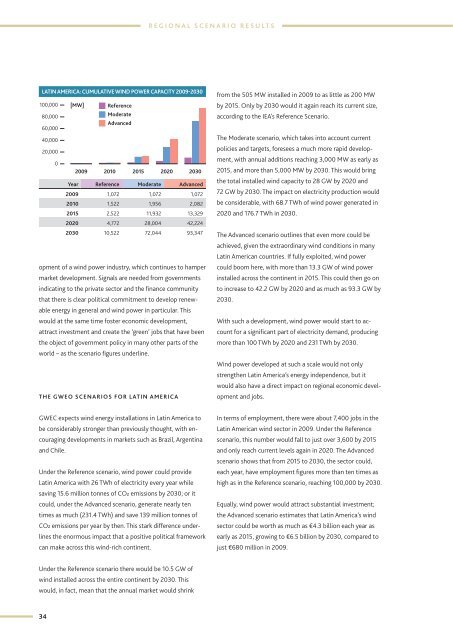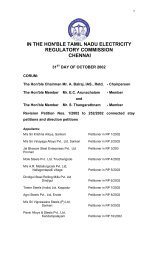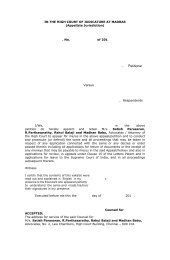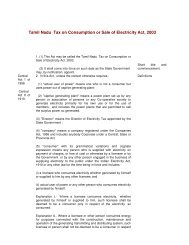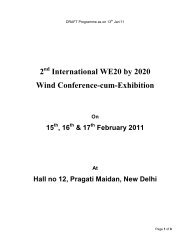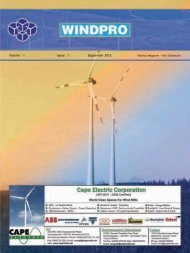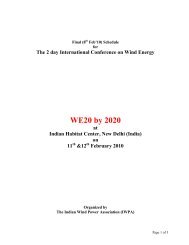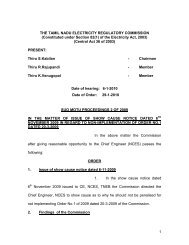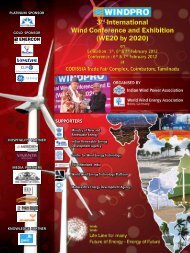glOBal Wind energy OuTlOOk 2010 - Global Wind Energy Council
glOBal Wind energy OuTlOOk 2010 - Global Wind Energy Council
glOBal Wind energy OuTlOOk 2010 - Global Wind Energy Council
Create successful ePaper yourself
Turn your PDF publications into a flip-book with our unique Google optimized e-Paper software.
R e g i o n a l s c e n a r i o r e s u l T S<br />
Latin aMerica: cuMulaTive <strong>Wind</strong> POWer capaciTY 2009-2030<br />
100,000 [MW] Reference<br />
80,000<br />
Moderate<br />
Advanced<br />
60,000<br />
40,000<br />
20,000<br />
0<br />
2009 <strong>2010</strong> 2015 2020 2030<br />
Year Reference Moderate Advanced<br />
2009 1,072 1,072 1,072<br />
<strong>2010</strong> 1,522 1,956 2,082<br />
2015 2,522 11,932 13,329<br />
2020 4,772 28,004 42,224<br />
2030 10,522 72,044 93,347<br />
opment of a wind power industry, which continues to hamper<br />
market development. Signals are needed from governments<br />
indicating to the private sector and the finance community<br />
that there is clear political commitment to develop renewable<br />
<strong>energy</strong> in general and wind power in particular. This<br />
would at the same time foster economic development,<br />
attract investment and create the ‘green’ jobs that have been<br />
the object of government policy in many other parts of the<br />
world – as the scenario figures underline.<br />
The GWEO scenariOS For Latin aMerica<br />
from the 505 MW installed in 2009 to as little as 200 MW<br />
by 2015. Only by 2030 would it again reach its current size,<br />
according to the IEA’s Reference Scenario.<br />
The Moderate scenario, which takes into account current<br />
policies and targets, foresees a much more rapid development,<br />
with annual additions reaching 3,000 MW as early as<br />
2015, and more than 5,000 MW by 2030. This would bring<br />
the total installed wind capacity to 28 GW by 2020 and<br />
72 GW by 2030. The impact on electricity production would<br />
be considerable, with 68.7 TWh of wind power generated in<br />
2020 and 176.7 TWh in 2030.<br />
The Advanced scenario outlines that even more could be<br />
achieved, given the extraordinary wind conditions in many<br />
Latin American countries. If fully exploited, wind power<br />
could boom here, with more than 13.3 GW of wind power<br />
installed across the continent in 2015. This could then go on<br />
to increase to 42.2 GW by 2020 and as much as 93.3 GW by<br />
2030.<br />
With such a development, wind power would start to account<br />
for a significant part of electricity demand, producing<br />
more than 100 TWh by 2020 and 231 TWh by 2030.<br />
<strong>Wind</strong> power developed at such a scale would not only<br />
strengthen Latin America’s <strong>energy</strong> independence, but it<br />
would also have a direct impact on regional economic development<br />
and jobs.<br />
GWEC expects wind <strong>energy</strong> installations in Latin America to<br />
be considerably stronger than previously thought, with encouraging<br />
developments in markets such as Brazil, Argentina<br />
and Chile.<br />
Under the Reference scenario, wind power could provide<br />
Latin America with 26 TWh of electricity every year while<br />
saving 15.6 million tonnes of CO2 emissions by 2030; or it<br />
could, under the Advanced scenario, generate nearly ten<br />
times as much (231.4 TWh) and save 139 million tonnes of<br />
CO2 emissions per year by then. This stark difference underlines<br />
the enormous impact that a positive political framework<br />
can make across this wind-rich continent.<br />
In terms of employment, there were about 7,400 jobs in the<br />
Latin American wind sector in 2009. Under the Reference<br />
scenario, this number would fall to just over 3,600 by 2015<br />
and only reach current levels again in 2020. The Advanced<br />
scenario shows that from 2015 to 2030, the sector could,<br />
each year, have employment figures more than ten times as<br />
high as in the Reference scenario, reaching 100,000 by 2030.<br />
Equally, wind power would attract substantial investment;<br />
the Advanced scenario estimates that Latin America’s wind<br />
sector could be worth as much as €4.3 billion each year as<br />
early as 2015, growing to €6.5 billion by 2030, compared to<br />
just €680 million in 2009.<br />
Under the Reference scenario there would be 10.5 GW of<br />
wind installed across the entire continent by 2030. This<br />
would, in fact, mean that the annual market would shrink<br />
34


